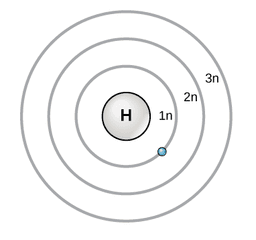
Review for Unit 1 - The Atom
Quiz by Pamela Chinik
Feel free to use or edit a copy
includes Teacher and Student dashboards
Measure skillsfrom any curriculum
Tag the questions with any skills you have. Your dashboard will track each student's mastery of each skill.
- edit the questions
- save a copy for later
- start a class game
- automatically assign follow-up activities based on students’ scores
- assign as homework
- share a link with colleagues
- print as a bubble sheet
- Q1
What are the limitations of Bohr's atomic model?
His model has electrons in orbits, but not arranged in probable electron clouds (s,p,d,f orbitals)
His model does not have the protons and neutrons in the nucleus
His model does not have a positive nucleus.
His model does not have negatively charged electrons in it.
60s - Q2
Which scientist developed a model for the atom where a positive and dense nucleus was located using a gold foil experiment?
Thomson
Bohr
Shrodinger
Rutherford
45s - Q3
What does the modern atomic model for the atom include?
The positively-charged nucleus with no mass that is orbited by electrons that exist in specific orbits like the planets orbiting the sun.
There is a dense positively-charged nucleus containing protons and neutrons surrounded by negative electrons that orbit in specifically shaped cloud orbitals.
There is a nucleus that contains negative neutrons and takes up most of the atom, surrounded by electrons that orbit in circles around the nucleus.
There is a positive nucleus surrounded by a cloud of electrons shaped like a sphere.
60s - Q4
Which of the numbers in the isotopic notation represents the mass number and explanation for what it equals?
22; this number is the sum of the protons and electrons.
22; this number is the sum of the protons and neutrons.
12; this is also the number of electrons.
12; this is also the number of neutrons.
60s - Q5
Based on this isotopic notation, how many neutrons does this isotope have?
12 neutrons
2 neutrons
10 neutrons
22 neutrons
60s - Q6
Based on this isotopic notation, how many protons and electrons does this ion have?
12 protons and 14 electrons
12 protons and 10 electrons
10 protons and 12 electrons
14 protons and 12 electrons
60s - Q7
A sample of an isotope was found in a chemical supply closet. It is labeled Strontium-92. What can you tell from this isotopic notation?
The mass of the isotope is 92, so you can determine the number of neutrons to be 54.
The number of neutrons in the isotope is 92, so the mass would equal 140.
The atomic number of the isotope is 92, so the electrons are also 92.
The mass of the isotope is 92, so you can find the number of protons to be 54.
60s - Q8
The average atomic mass of Lithium listed in the periodic table is 6.94 amu. Which isotope of Lithium is the most abundant?
Lithium-7 because it is closest to the rounded average atomic mass.
All of the isotopes of Lithium must have the same abundance.
Lithium-8 because it has the highest number of neutrons.
Lithium-6 because it is less than the rounded atomic mass.
60s - Q9
What are the number of protons, neutrons, and electrons in Phosphorus-35
15, 15, 15
35, 15, 15
20, 35, 15
15, 20, 15
60s - Q10
Mystery element Q has two known isotopes. Q-340 has an abundance of 85.2% and Q-345 has an abundance of 14.8%. Which of the following is true?
The average atomic mass will be closest to 342.5 because that is the average of the two isotope masses.
The average atomic mass will be closer to 345 because that isotope has the most neutrons.
The average atomic mass will be closer to 340 because that isotope is most abundant.
60s - Q11
What is the isotopic symbol for an atom with 56 protons and 84 neutrons?
Barium 137
Barium-140
Barium-56
Barium-84
60s - Q12
Fusion releases a massive amount of energy and occurs when two small nuclei ________
Lose electrons to become charged.
Combine together to make the same element with more protons.
Split apart to form two smaller elements.
Combine together to make a new, heavier element.
60s - Q13
Fission is the splitting of_______
a heavy nucleus into two smaller nuclei that are new elements.
a small nucleus into the subatomic particles that make it up.
neutrons to create an isotope with less mass.
an electron in order to emit colored light.
60s - Q14
What happens when an element absorbs heat energy?
Electrons fall back down to ground state emitting light.
Protons are excited and move out into orbit around the nucleus.
The nucleus is split apart.
Electrons are excited and move from a lower energy level to a higher one.
60s - Q15
What happens when an electron falls from a higher energy level to a lower one?
A proton is converted into a neutron.
Light energy is emitted as a specific color.
Heat energy is absorbed by the atom.
A nucleus is split into two smaller nuclei.
60s